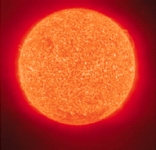Courtesy of Lindsey Dawson.
 A strange and confusing story about the sun appeared on the New Zealand Herald’s front page on October 1. Alongside a NASA picture (similar to this one), the Herald informed readers that the sun’s surface currently has only one spot of surface activity and that our star has been quiet for more than a year. In other words, we’re in a period of what’s called a “solar minimum”.
A strange and confusing story about the sun appeared on the New Zealand Herald’s front page on October 1. Alongside a NASA picture (similar to this one), the Herald informed readers that the sun’s surface currently has only one spot of surface activity and that our star has been quiet for more than a year. In other words, we’re in a period of what’s called a “solar minimum”.
Then, in a wonderful non sequitur, the paper went on to burble about how, soon, the sun will be “turning on the heat for us this summer”. Oh gosh, what a surprise.
Nice to know that our spring and early summer “are likely to be settled and drier than normal”. What the paper didn’t say is that a major flare-up of pesky sun spots – magnetic storms whose flares can blast Planet Earth with charged particles – will begin to happen in the next year or two. And it’ll have nothing to do with enjoying life at the beach.
Solar storms roll around like clockwork every 11 years, and the next bunch will erupt during the next four years, peaking at the “solar maximum” in 2012. The last lot happened in 2001 and given that we can’t remember anything odd happening then, it would seem we have little to worry about with the 2012 sun spots.
But. In 2006 scientists at NASA issued a prediction that the 2012 event will be the most intense solar maximum in 50 years. The prediction came from a team led by Mausumi Dikpati of the National Center for Atmospheric Research (NCAR). "The next sunspot cycle will be 30% to 50% stronger than the previous one," she said. If she’s right we’ll see a burst of solar activity second only to the historic solar max of 1958.
Says the NASA website: “That was a solar maximum. The Space Age was just beginning: Sputnik was launched in Oct. 1957 and Explorer 1 (the first US satellite) in Jan. 1958. In 1958 you couldn't tell that a solar storm was underway by looking at the bars on your cell phone; cell phones didn't exist. Even so, people knew something big was happening when Northern Lights were sighted three times in Mexico. A similar maximum now would be noticed by its effect on cell phones, GPS, weather satellites and many other modern technologies.”
We may well worry about that bland blanket phrase “other modern technologies”. The business of the whole world now runs on satellites. Online banking and business. The entire internet. Trillions of emails. Aircraft navigation. You name it, we need the technology. Major sun storm activity sounds dicey – especially given that the solar max of 1989 induced such huge magnetic disturbances across Canada that Quebec’s power grid failed.
Solar physicist David Hathaway of the National Space Science & Technology Center also thinks we have a doozy of a sunspot cycle coming up, but, interestingly enough, back in 2006 he was predicting it to begin in 2007. And here we are in late 2008 with the sun still snoozing. Calm before the storm, maybe. Or maybe just another indication of the peril that can dog scientists who dare to make predictions.









Bluz - 15 years ago
Interesting how these minor details are missed out.I only hope the world is prepared this when it does arrive.